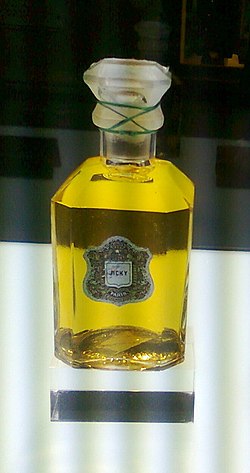Jicky
| Jicky | |
|---|---|
 | |
| Fragrance by Guerlain | |
| Category | Amber (Oriental) Fougère |
| Designed for | Unisex |
| Top notes |
|
| Heart notes |
|
| Base notes |
|
| Released | 1889 |
| Label | Guerlain |
| Perfumer(s) | Aimé Guerlain |
| Concentration | Parfum, Eau de Parfum |
| Website | Jicky |
Jicky is a perfume originally created by Aimé Guerlain in 1889 for French perfume and cosmetics house Guerlain. Introduced in 1889, it is the oldest continuously produced perfume in the world.[1]
History
[edit]Jicky was one of the first perfumes created with the addition of synthetic materials,[2] and was the first abstract perfume in history, meaning it is not based on a single note.[3] Its perfume notes include: spice, lemon, lavender, wood and vanilla. Its stopper is shaped like a champagne cork.[4]
Jicky was the nickname of Aimé Guerlain's nephew, Jacques Guerlain, and according to legend, was also the pet name of Aimé's girlfriend from his time studying in England.[5]
Jicky was featured in the exhibition, The Art of Scent 1889–2012, curated by Chandler Burr at the Museum of Arts and Design, New York.[6] This exhibition tracks the evolution and major innovations in scent design, since the dawn of the synthetic aroma compound in the late nineteenth century.[7] Each of the scents in the exhibition is aligned to a historical art movements, with Jicky aligned with romanticism to reflect the emerging bourgeois French society.[8]
See also
[edit]- Mitsouko, created by perfumer Jacques Guerlain in 1919
- Shalimar, the flagship fragrance of perfume house Guerlain, created by Jacques Guerlain in 1921
References
[edit]- ^ Turin, Luca; Sanchez, Tania (2008). Perfumes: The A-Z Guide. London: Penguin. ISBN 978-0-670-01865-9.
- ^ "Jicky". Fragrantica. Retrieved 21 November 2014.
- ^ "Jicky". Base Notes. Retrieved 21 November 2014.
- ^ "Jicky". Neiman Marcus. Retrieved 21 November 2014.
- ^ "Jicky by Guerlain". Fragrantica. Retrieved 23 November 2022.
- ^ "the art of scent". chandler burr. Retrieved 6 August 2024.
- ^ "The Art of Scent: 1889 - 2012". Museum of Art and Design. Retrieved 6 August 2024.
- ^ Spayde, J (2020). "'The Craft of Scent'". American Craft. 80 (4): 34–41 – via ebscohost.
